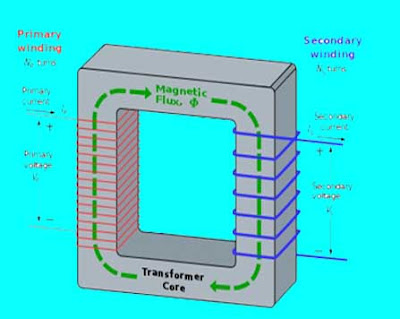What Is A Transformer
A Transformer is a static electrical device that transfers AC electrical energy from one circuit to the other circuit without losing any power and frequency, but the voltage level can be changed which means voltage can be increased or decreased according to the specification.It operates on the law of Faraday’s Law of Electromagnetic Induction which says that “ the magnitude of voltage is directly proportional to the rate of change of flux.”
The idea for transforming the voltage on a much higher level is that higher distribution voltages mean lower currents for that equal power and therefore lower I2*R losses forward the networked network of cables.
These higher AC transmission voltages and currents can then be decreased to a much cheaper, safer, and usable voltage level where it can be used to provide electrical appliances in our houses and workplaces, and all this is probable thanks to some basic Voltage Transformer.
Transformers are various commonly used for improving low AC voltages at large current or decreasing high AC voltages at low current in electric power utilization, and for joining the stages of sign processing circuits.
Transformers can too be utilized for isolation, where this voltage equals the voltage out, with separate loops not electrically bonded to one difference.
 |
| What Is a Transformer |
Types Of Transformer
Core Type Transformer:-In this Core Type transformer, the windings are provided to the essential part of the circuit in this core type of the transformer.
The coils applied are of form-wound and round type on the core type. It must a single magnetic circuit.
In core-type transformer, these coils are injured in helical bands with different layers isolated from each different by materials like mica.
The core is possessing two rectangular parts and the coils are placed on both the parts in the core type.
Shell Type Transformer:-
Shell type transformers are the most popular and efficient type of transformers. The shell-type transformer has a dual magnetic circuit.The center has three limbs and both the winding are located on the center limbs. The core encompasses most parts of the winding.
Generally, multi-layer plates and sandwich coils are done in shell type.
Every high voltage winding is in between two low voltage coils and low voltage coils are most related to the top and bottom of these yokes.
The shell-type structure is frequently preferred for operating at a very large voltage of the transformer.
Natural cooling does not survive in this shell-type transformer as the winding into the shell type is enclosed by the core itself. The huge number of winding is required to be removed for better support.
Note: Also Different Type of transformer they are cover in my other article.
Working of Transformer
The working principle of a transformer is very easy. Mutual induction connecting two or more windings or Coil allows for electrical energy to be transferred between circuits. |
| Working Of Transformer |
Let us immediately shift our attention to our primary requirement: How do transformers work? The operation of the transformer mainly operates on the principle of common inductance between two circuits linked to a common magnetic flux.
A transformer is primarily used for the transformation of electrical energy.
Transformers consist of types of handling coils as a primary winding and auxiliary windings.
The input coil is called the primary winding and the output coil is called the secondary winding of the transformer.
There is no electrical contact within the two coils; instead, they are joined by an alternating magnetic field produced in the soft-iron core from the transformer.
The two lines in the center of the circuit symbol design the core. Transformers wear very small power so the power out is approximately equal to the power.
The primary coil and the secondary coil posses large mutual inductances. If one of the coils is attached to the source of alternating voltage, then an alternating flux will fix up in the covered core.
The flux gets joined up with the other coil and an electromagnetic force is produced, as per Faraday’s law of electromagnetic inductance.
e = M di/dt Where e is induced EMF M is the mutual inductance
If the second coil is closed when the current in the coil is transferred from the primary coil of the transformer to the secondary coil.
Application of transformer
- The transformer utilized for impedance matching.
- The transformer used to isolate two circuits electrically.
- The transformer used in the rectifier.
- It is used to improve or decrease the alternating voltages in electric power System.
- The transformer used for step-up under voltage in case of measurement.
- The transformer used to step down the high voltage for safety.
- The transformer used in voltmeter, ammeters, protective relay, etc
- It is used in voltage regulators, voltage stabilizers, power supplies, etc.




0 Comments